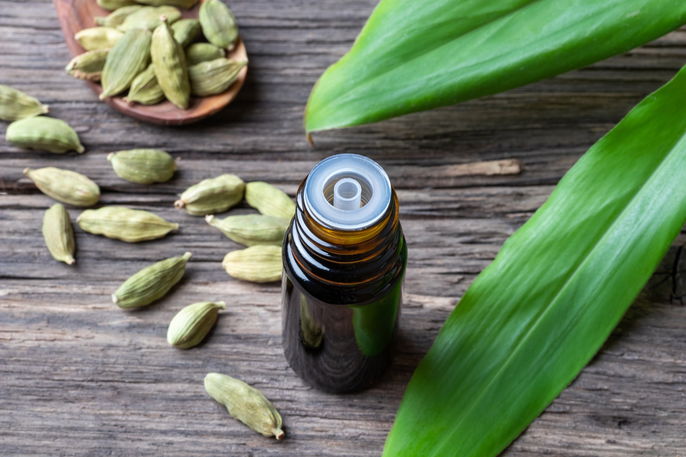Cardamom is an aromatic herb that is widely used in Indian cuisine to to season rice and meat. It can also be prepared as a tea or used in recipes for desserts.
This plant is rich in flavonoids and other substances, which give it antioxidant, relaxing, anti-inflammatory and bactericidal properties. It can offer several health benefits, such as improving digestion, controlling blood pressure, reducing bad breath and even preventing chronic diseases like heart disease, cancer and diabetes.
The scientific name of cardamom is Elletaria cardamomum and its taste can be described as menthol-like, but peppery and floral. It can be purchased in health food stores, grocery stores and farmer's markets in the form of berries, capsules, powder or as an essential oil.

What it's used for
Cardamom is rich in vitamin C, flavonoids and antioxidants like quercetin, kaempferol and luteolin. Therefore, it can be used for:
1. Maintaining oral health
Cardamom contains antimicrobial and bactericidal properties that prevents and treats cavities and other oral infections, like gingivitis and thrush. It has a refreshing taste, and can also be used to prevent or get rid of bad breath.
2. Preventing nausea
Cardamom essential oil has antiemetic properties and can be used for aromatherapy inhalations to help combat nausea, nausea or vomiting.
It also has digestive properties, and can be made into a tea to improve indigestion and gas.
3. Managing high blood pressure
The flavonoids and essential oils present in cardamom have anti-inflammatory action that promote optimal arterial health. It can help to ensure regular blood flow, while managing blood pressure levels.
Also recommended: 9 Symptoms of High Blood Pressure tuasaude.com/en/symptoms-of-high-blood-pressureCardamom also has a diuretic action that stimulates the body to eliminate excess sodium through urine. Therefore it can also be taken to help with the management of high blood pressure.
4. Preventing diabetes
Cardamom is rich in polyphenols which contain antioxidant and anti-inflammatory properties. These can optimize the way insulin works and ensure glucose is slowly absorbed into the body's cells to prevent high glucose levels and diabetes.
Furthermore, cardamom can also improve irison levels. This a hormone that is produced during physical activity (either low or intense) and is useful for regulating and improving insulin sensitivity.
5. Preventing cancer
Because it is rich in antioxidants like tocopherol, quercetin and luteolin, cardamom can prevent the formation of free radicals in the body. Lower concentrations of free radicals are associated with a lower risk for various types of cancer, such as lung, bladder and kidney cancer.
6. Promoting weight loss
As mentioned, cardamom helps to increase irisin levels in the blood. This hormone contains thermogenic properties that can affect metabolism, and how energy in the body is burned.
The combination of cardamom's ability to keep irison levels at optimal levels and its naturally antioxidant effect can help to reduce fat absorption from food.
7. Reducing LDL cholesterol
Because it is a powerful antioxidant, cardamom can help reduce cholesterol production, as well as fat absorption in the gut. This can lead to lower LDL levels in the blood.
Furthermore, cardamom is a potent anti-inflammatory that promotes optimal HDL cholesterol levels. This can play a role in preventing diseases such as atherosclerosis, heart attack and stroke.
8. Optimizing the treatment of fatty liver
Because it is rich in antioxidant polyphenols, such as luteolin and quercetin, cardamom can reduce the production of free radicals. It cann prevent excess fat storage in the liver and therefore help to to treat fatty liver.
Furthermore, cardamom is a powerful anti-inflammatory that can protect the liver and improve its functioning.
How to use

Cardamom is a very versatile spice that can be used to prepare teas, to substitute for garlic in sauteed dishes or to add flavor to desserts like puddings, fruit salads or jellies. You can also flavor bread with this herb or add it to meat sauces.
- Cardamom tea: To make tea, simply add 20 grams of cardamom powder to a cup of boiling water. It can also be made with 10 grams of cardamom seeds added to 1 liter of boiling water, which is then strained. Drink after meals while still warm.
- Essential oil: It can be diluted in vegetable oil, such as coconut or jojoba, and added to baths or used as a gargle. The essential oil can also be used in its pure form for inhalation as well;
- Capsules: Widely used in Ayurvedic medicine, the capsule should be ingested with a glass of water before meals.
It is worth noting that it is important to consult a doctor or medicinal plant specialist before using cardamom for medicinal purposes.
To achieve the benefits of cardamom, it is essential to maintain a healthy diet and an active lifestyle.
Side effects and contraindications
Cardamom can cause gallstones formation and abdominal cramping in some people. Therefore, this spice should not be used by people with a history of gallstones.
Furthermore, cardamom should not be consumed by women who are pregnant or breastfeeding, as there is not enough data on the safety of using this spice in these populations.






























